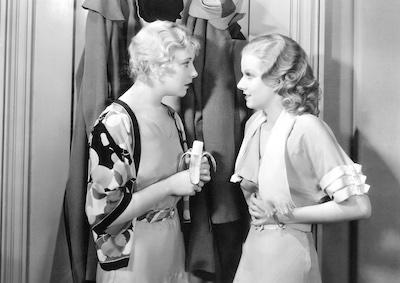Red-Headed Woman
U.S., 1932
Lil “Red” Andrews, played by platinum blonde Jean Harlow in a red wig, is a small-town secretary with designs on her married boss. But unlike the darker undertones of the later Baby Face (Alfred E. Green, 1933), Red is flirting with and winking at the audience from the jump, making Red-Headed Woman stand out as a farcical romp amid the bleaker dramatic fare of the era. This star-cementing turn for Harlow was nearly not hers to enjoy: MGM bought Katharine Brush’s novel of the same name with the intention to use it as a Greta Garbo vehicle, and, at various points before production, both Barbara Stanwyck and Clara Bow were also rumored to be attached. According to scholar Cari Beauchamp in her 1997 book, Without Lying Down, “Anita enjoyed Jean enormously [and was] convinced that the actress evoked the right attitude to make the audience laugh with her as she sashays her way up a string of men, each richer and older than the one before.” While this marked Loos and Harlow’s first time working together, they would reteam for four additional films, including Hold Your Man (1933, also screening in this series) and Harlow’s final film, Saratoga (1937), which was completed after her death at age 26 using stand-ins.
Themes of infidelity and gold-digging blend deliciously with Loos’ signature double entendre dialogue and debauched scenarios—which also meant that the film barely squeaked by the increasingly powerful censors of pre-Code Hollywood. In fact, women’s clubs and the Catholic church held up Red-Headed Woman as a prime example of the failure of the Hays Office. But the backlash didn’t impact Loos’ career: that same year, she would pen the dialogue for the Marion Davies vehicle, Blondie of the Follies, also for MGM.
35mm, b&w, 79 min. Director: Jack Conway. Screenwriter: Anita Loos. Based on the novel Red-Headed Woman by Katharine Brush. With: Jean Harlow, Chester Morris, Lewis Stone.
Blondie of the Follies
U.S., 1932
When the ambitious Lottie Callahan (Billie Dove), who grew up with the good-natured Blondie McClune (Marion Davies), leaves their decrepit tenement building to join the follies, Blondie isn’t interested in show business—but can also barely afford a new dress. When Lottie returns home on Mother’s Day with a new name and an even newer wardrobe, Blondie is gradually wooed to the life of glamor promised by the follies, where her act becomes a smash hit. Will her immediate success impact their friendship—or will it be the undoing of both their careers? Originally developed by prolific screenwriter and frequent Loos collaborator Frances Marion as a vehicle for Marion Davies, who herself spent time performing with the Ziegfield Follies in the late 1910s, Blondie of the Follies was reportedly Hearst’s favorite film starring Davies, his mistress of over 30 years with whom he first became enamored when he caught her in a Ziegfield performance. It shouldn’t come as a surprise that the newspaper tycoon exercised a heavy hand over rewrites to the original script to emphasize Davies’ abilities as a dramatic actress, reportedly demanding that Loos “curb [her] inclination toward humor [...] I see this story as a great romance.” Regardless of Hearst’s intentions, Davies’ aptitude for light comedy and her known capacity to thrive as the life of any party is what shines in Lottie and Blondie’s parallel stories of upward mobility. The noted film critic Pauline Kael supposedly told Loos in the mid-1970s that Blondie of the Follies “still holds up quite well.” We are inclined to feel the same.
35mm, b&w, 90 min. Director: Edmund Goulding. Story: Frances Marion. Dialogue: Anita Loos. With: Marion Davies, Robert Montgomery, Billie Dove.
Print courtesy of the Library of Congress.






 Mobile Navigation
Mobile Navigation

